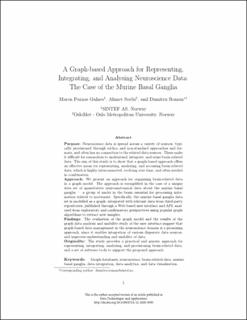| dc.contributor.author | Parnas Gulnes, Maren | |
| dc.contributor.author | Soylu, Ahmet | |
| dc.contributor.author | Roman, Dumitru | |
| dc.date.accessioned | 2022-08-31T15:47:50Z | |
| dc.date.available | 2022-08-31T15:47:50Z | |
| dc.date.created | 2021-11-12T19:39:23Z | |
| dc.date.issued | 2021 | |
| dc.identifier.citation | Data Technologies and Applications. 2021, 56 (3), 358-381. | en_US |
| dc.identifier.issn | 2514-9288 | |
| dc.identifier.uri | https://hdl.handle.net/11250/3014769 | |
| dc.description.abstract | Purpose: Neuroscience data are spread across a variety of sources, typically provisioned through ad-hoc and non-standard approaches and formats and often have no connection to the related data sources. These make it difficult for researchers to understand, integrate and reuse brain-related data. The aim of this study is to show that a graph-based approach offers an effective mean for representing, analysing and accessing brain-related data, which is highly interconnected, evolving over time and often needed in combination.
Approach: The authors present an approach for organising brain-related data in a graph model. The approach is exemplified in the case of a unique data set of quantitative neuroanatomical data about the murine basal ganglia––a group of nuclei in the brain essential for processing information related to movement. Specifically, the murine basal ganglia data set is modelled as a graph, integrated with relevant data from third-party repositories, published through a Web-based user interface and API, analysed from exploratory and confirmatory perspectives using popular graph algorithms to extract new insights.
Findings: The evaluation of the graph model and the results of the graph data analysis and usability study of the user interface suggest that graph-based data management in the neuroscience domain is a promising approach, since it enables integration of various disparate data sources and improves understanding and usability of data.
Originality: The study provides a practical and generic approach for representing, integrating, analysing and provisioning brain-related data and a set of software tools to support the proposed approach. | en_US |
| dc.language.iso | eng | en_US |
| dc.publisher | Emerald | en_US |
| dc.rights | Navngivelse-Ikkekommersiell 4.0 Internasjonal | * |
| dc.rights.uri | http://creativecommons.org/licenses/by-nc/4.0/deed.no | * |
| dc.subject | Graph databases | en_US |
| dc.subject | Neuroscience | en_US |
| dc.subject | Brain-related data | en_US |
| dc.subject | Murine basal ganglia | en_US |
| dc.subject | Data integration | en_US |
| dc.subject | Data analytics | en_US |
| dc.subject | Data visualisation | en_US |
| dc.title | A graph-based approach for representing, integrating and analysing neuroscience data: the case of the murine basal ganglia | en_US |
| dc.type | Peer reviewed | en_US |
| dc.type | Journal article | en_US |
| dc.description.version | acceptedVersion | en_US |
| dc.source.pagenumber | 358-381 | en_US |
| dc.source.volume | 56 | en_US |
| dc.source.journal | Data Technologies and Applications | en_US |
| dc.source.issue | 3 | en_US |
| dc.identifier.doi | 10.1108/DTA-12-2020-0303 | |
| dc.identifier.cristin | 1954226 | |
| cristin.ispublished | true | |
| cristin.fulltext | postprint | |

